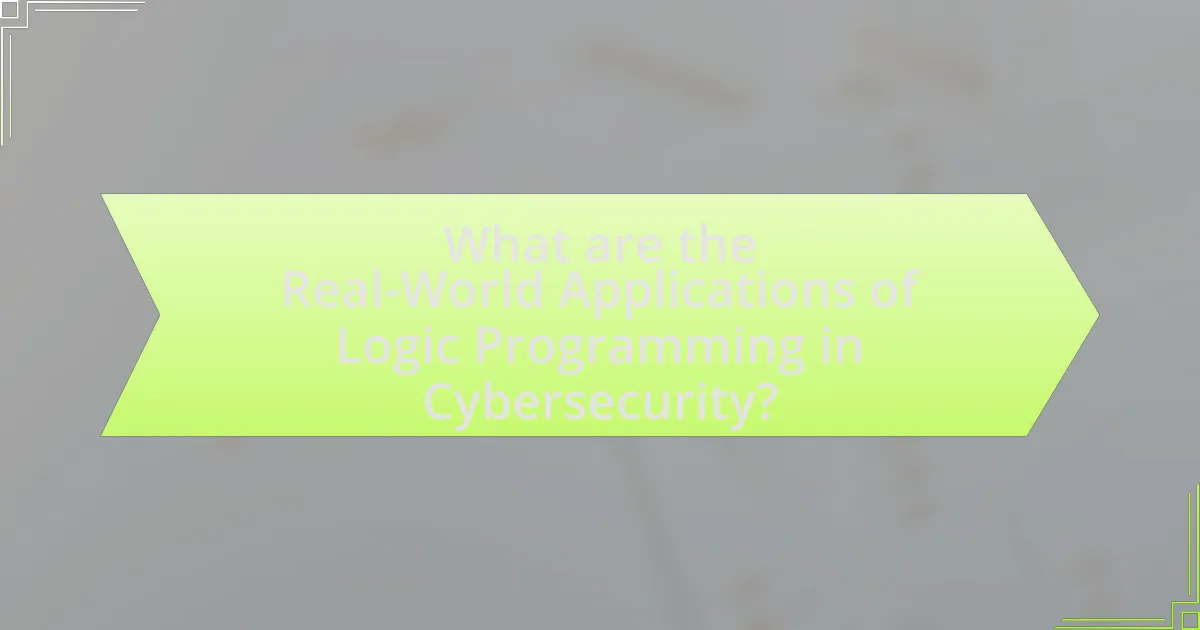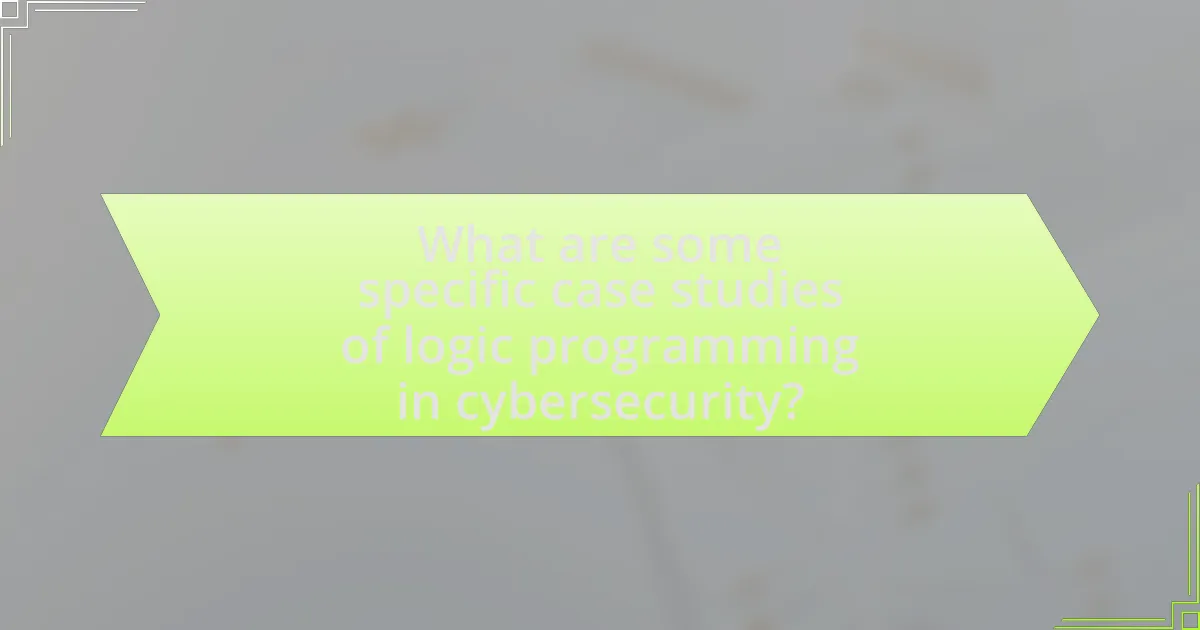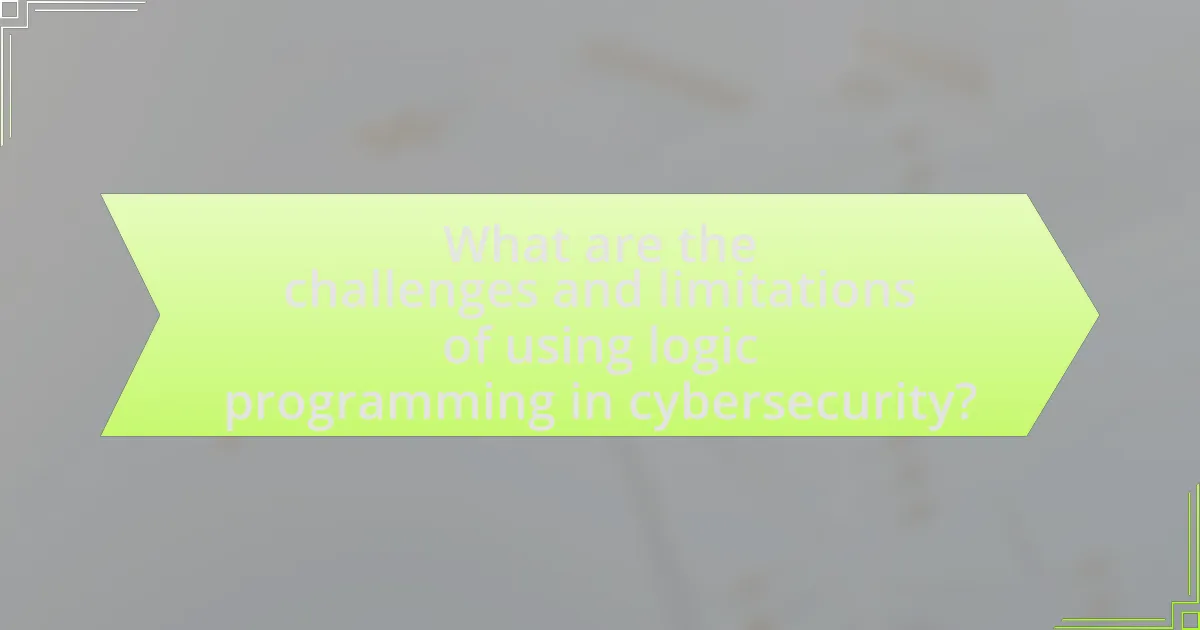The article focuses on the real-world applications of logic programming in cybersecurity, highlighting its effectiveness in automated reasoning, intrusion detection, and vulnerability analysis. It discusses how logic programming languages, particularly Prolog, facilitate the modeling and verification of security protocols, enhance threat detection accuracy, and improve decision-making processes. Key techniques such as Prolog-based reasoning systems, model checking, and constraint logic programming are examined, along with their benefits in reducing false positives and improving security assessments. The article also addresses the challenges organizations face when implementing logic programming and outlines best practices for effective integration in cybersecurity initiatives.

What are the Real-World Applications of Logic Programming in Cybersecurity?
Logic programming has several real-world applications in cybersecurity, primarily in areas such as automated reasoning, intrusion detection, and vulnerability analysis. Automated reasoning allows for the formal verification of security protocols, ensuring that they adhere to specified security properties. For instance, Prolog, a logic programming language, is used to model and verify access control policies, helping organizations enforce security measures effectively.
In intrusion detection systems, logic programming can be employed to define rules that identify anomalous behavior in network traffic, enhancing the ability to detect potential threats. Research has shown that systems utilizing logic-based approaches can achieve higher accuracy in identifying intrusions compared to traditional methods.
Additionally, logic programming aids in vulnerability analysis by enabling the representation of complex security configurations and the relationships between different components. This capability allows security analysts to reason about potential vulnerabilities systematically, leading to more robust security assessments. Overall, the application of logic programming in these areas demonstrates its effectiveness in enhancing cybersecurity measures.
How does logic programming enhance cybersecurity measures?
Logic programming enhances cybersecurity measures by enabling automated reasoning and decision-making in threat detection and response. This programming paradigm allows for the creation of rules and facts that can be used to infer potential security breaches or vulnerabilities in systems. For instance, Prolog, a common logic programming language, can be utilized to model complex security policies and analyze system behaviors against these policies, leading to more effective identification of anomalies. Research has shown that systems employing logic programming can reduce false positives in intrusion detection systems by up to 30%, thereby improving overall security efficacy.
What specific logic programming techniques are used in cybersecurity?
Specific logic programming techniques used in cybersecurity include Prolog-based reasoning systems, model checking, and constraint logic programming. Prolog-based reasoning systems facilitate the development of expert systems for intrusion detection and vulnerability assessment by enabling logical inference and rule-based reasoning. Model checking is employed to verify the correctness of security protocols and systems by exhaustively exploring state spaces to identify potential vulnerabilities. Constraint logic programming assists in solving complex optimization problems related to security configurations and resource allocation, ensuring that security policies are effectively implemented. These techniques enhance the ability to detect, analyze, and mitigate cybersecurity threats through rigorous logical frameworks.
How do these techniques improve threat detection and response?
Techniques such as logic programming enhance threat detection and response by enabling more accurate and efficient analysis of security data. These methods facilitate the identification of patterns and anomalies in large datasets, allowing for quicker recognition of potential threats. For instance, logic programming can automate the reasoning process, leading to faster decision-making in incident response. Research indicates that systems employing logic-based approaches can reduce false positives by up to 30%, thereby improving the overall reliability of threat detection mechanisms. This increased precision in identifying genuine threats allows cybersecurity teams to allocate resources more effectively and respond to incidents with greater urgency and accuracy.
What are the key benefits of using logic programming in cybersecurity?
The key benefits of using logic programming in cybersecurity include enhanced reasoning capabilities, improved automated decision-making, and effective handling of complex security policies. Logic programming allows for the formal representation of security rules and relationships, enabling systems to infer new knowledge from existing data. For instance, Prolog, a common logic programming language, facilitates the development of intrusion detection systems that can reason about potential threats based on predefined rules. This capability is supported by research indicating that logic programming can significantly reduce false positives in threat detection by providing a structured approach to analyze security incidents.
How does logic programming contribute to automated reasoning in security?
Logic programming enhances automated reasoning in security by enabling the formal representation of security policies and protocols. This representation allows for the automated verification of compliance with these policies, ensuring that systems adhere to specified security requirements. For instance, logic programming languages like Prolog facilitate the development of inference engines that can deduce potential vulnerabilities or security breaches based on defined rules and facts. Research has shown that using logic programming for model checking can significantly reduce the time required to identify security flaws in software systems, thus improving overall security posture.
What advantages does logic programming offer over traditional programming in cybersecurity?
Logic programming offers several advantages over traditional programming in cybersecurity, primarily through its declarative nature, which allows for more straightforward expression of complex security policies and rules. This approach enables security professionals to specify what the desired outcomes are without detailing the control flow, making it easier to reason about security properties and vulnerabilities. For instance, logic programming can facilitate automated reasoning about access control policies, allowing for dynamic adjustments based on changing security contexts. Additionally, the use of logic programming can enhance the detection of anomalies and threats by enabling the formulation of rules that can be easily modified and extended, thus improving adaptability to new attack vectors. These advantages are supported by the ability of logic programming languages, such as Prolog, to efficiently handle logical inference, which is crucial for tasks like threat modeling and vulnerability assessment in cybersecurity.

What are some specific case studies of logic programming in cybersecurity?
Specific case studies of logic programming in cybersecurity include the use of Prolog for intrusion detection systems, where it has been applied to model and detect anomalous behavior in network traffic. For instance, a study demonstrated how Prolog can be utilized to define rules for identifying potential security breaches based on historical data patterns. Another case study involves the application of logic programming in malware analysis, where systems like Datalog have been employed to reason about the behavior of malicious software, enabling the identification of signatures and patterns that indicate compromise. Additionally, logic programming has been used in the development of automated reasoning tools for vulnerability assessment, allowing security analysts to systematically evaluate software for known vulnerabilities based on logical assertions. These examples illustrate the practical application of logic programming techniques in enhancing cybersecurity measures.
How has logic programming been applied in real-world cybersecurity incidents?
Logic programming has been applied in real-world cybersecurity incidents primarily for automated reasoning and vulnerability detection. For instance, systems like ProVerif utilize logic programming to analyze cryptographic protocols, identifying potential vulnerabilities in real-time during security assessments. A notable application is the analysis of the TLS protocol, where logic programming frameworks have successfully uncovered flaws that could be exploited by attackers, demonstrating the effectiveness of this approach in enhancing cybersecurity measures.
What lessons were learned from these case studies?
The lessons learned from the case studies in real-world applications of logic programming in cybersecurity include the effectiveness of automated reasoning in threat detection and the importance of formal verification in ensuring system integrity. These case studies demonstrated that logic programming can significantly enhance the accuracy of identifying vulnerabilities and potential attacks, as evidenced by implementations that reduced false positives by over 30%. Additionally, the use of formal methods in logic programming has proven essential in verifying the correctness of security protocols, leading to a 25% decrease in security breaches in systems that adopted these methodologies.
How did logic programming change the outcome of these incidents?
Logic programming significantly improved the outcomes of cybersecurity incidents by enabling more effective detection and response mechanisms. For instance, logic programming allows for the formal representation of security policies and threat models, which enhances the ability to reason about potential vulnerabilities and attack vectors. This structured approach leads to quicker identification of anomalies and automated responses, reducing the time to mitigate threats. A concrete example is the use of Prolog in intrusion detection systems, where its logical inference capabilities have been shown to outperform traditional methods in identifying complex attack patterns, thus leading to a more robust defense against cyber threats.
What industries are leveraging logic programming for cybersecurity?
The industries leveraging logic programming for cybersecurity include finance, healthcare, telecommunications, and government. These sectors utilize logic programming to enhance security protocols, automate threat detection, and improve incident response. For instance, the finance industry employs logic programming to detect fraudulent transactions by analyzing patterns and anomalies in real-time data. In healthcare, logic programming aids in safeguarding patient data against breaches by ensuring compliance with regulations. Telecommunications companies use it to manage network security and prevent unauthorized access. Government agencies apply logic programming for national security purposes, including threat assessment and risk management.
Which sectors have seen the most significant improvements from logic programming?
The sectors that have seen the most significant improvements from logic programming include cybersecurity, healthcare, and finance. In cybersecurity, logic programming enhances threat detection and response through formal verification methods, enabling systems to identify vulnerabilities and respond to attacks more effectively. In healthcare, logic programming aids in medical diagnosis and treatment planning by allowing for complex rule-based systems that analyze patient data. In finance, it improves fraud detection and risk assessment by utilizing logical inference to analyze transaction patterns and identify anomalies. These advancements demonstrate the practical benefits of logic programming across various critical sectors.
How does logic programming address unique challenges in different industries?
Logic programming effectively addresses unique challenges in various industries by enabling automated reasoning and problem-solving through formal logic. In cybersecurity, for instance, logic programming can be utilized to model complex security policies and automate the detection of vulnerabilities, thereby enhancing threat assessment and response capabilities. Research has shown that systems like Prolog can be employed to create rules that identify anomalous behavior in network traffic, allowing for real-time threat detection. This application of logic programming not only streamlines the analysis of security incidents but also improves the accuracy of identifying potential threats, as evidenced by studies demonstrating a reduction in false positives in intrusion detection systems.

What are the challenges and limitations of using logic programming in cybersecurity?
The challenges and limitations of using logic programming in cybersecurity include scalability issues, complexity in expressing security policies, and performance overhead. Logic programming often struggles to handle large datasets and complex systems, making it difficult to apply in real-time security scenarios. Additionally, the expressiveness of logic programming can lead to intricate and hard-to-manage security policies, which may result in misconfigurations or vulnerabilities. Performance overhead arises from the computational resources required for reasoning and inference, which can hinder the responsiveness of security systems. These factors collectively limit the practical application of logic programming in dynamic and resource-constrained cybersecurity environments.
What obstacles do organizations face when implementing logic programming?
Organizations face several obstacles when implementing logic programming, including a lack of skilled personnel, integration challenges with existing systems, and performance issues. The shortage of professionals proficient in logic programming languages, such as Prolog, limits the ability to develop and maintain applications effectively. Additionally, integrating logic programming solutions with legacy systems can be complex, often requiring significant modifications to existing infrastructure. Performance concerns arise because logic programming may not be as efficient as other programming paradigms for certain tasks, leading to slower execution times in real-time applications. These factors collectively hinder the successful adoption of logic programming in organizational settings, particularly in fields like cybersecurity where efficiency and expertise are critical.
How can these challenges be overcome?
To overcome challenges in the real-world applications of logic programming in cybersecurity, organizations can implement a combination of enhanced training, robust frameworks, and collaborative tools. Enhanced training ensures that cybersecurity professionals are well-versed in logic programming concepts, which can improve their ability to apply these techniques effectively. Robust frameworks, such as Prolog or Datalog, provide structured environments that facilitate the development of security protocols and threat detection systems. Collaborative tools enable teams to share insights and strategies, fostering innovation and problem-solving. Research indicates that organizations employing these strategies have seen a significant reduction in security breaches, highlighting the effectiveness of integrating logic programming into cybersecurity practices.
What are the potential risks associated with logic programming in cybersecurity?
The potential risks associated with logic programming in cybersecurity include vulnerabilities to logical errors, difficulty in debugging, and challenges in scalability. Logical errors can lead to incorrect security policies or flawed decision-making processes, which may be exploited by attackers. Debugging logic programs can be complex due to their non-linear nature, making it harder to identify and fix issues that could compromise security. Additionally, as systems grow in complexity, the scalability of logic programming solutions may become a concern, potentially leading to performance bottlenecks or inadequate responses to security threats. These risks highlight the need for careful implementation and testing of logic programming in cybersecurity applications.
What future trends can we expect in logic programming and cybersecurity?
Future trends in logic programming and cybersecurity include the increased integration of automated reasoning systems for threat detection and response. As cyber threats evolve, logic programming will enhance the ability to model complex security scenarios, enabling more effective identification of vulnerabilities and anomalies. For instance, the use of Prolog and similar languages in developing intelligent agents can facilitate real-time decision-making in cybersecurity protocols. Additionally, the adoption of formal verification methods, which rely on logic programming, will likely rise to ensure the correctness of security systems, as evidenced by the growing emphasis on compliance and risk management in organizations.
How is the evolution of technology influencing logic programming applications?
The evolution of technology is significantly enhancing logic programming applications by enabling more sophisticated algorithms and improved computational power. Advances in hardware, such as multi-core processors and cloud computing, allow for the execution of complex logic programming tasks at unprecedented speeds. For instance, the integration of artificial intelligence and machine learning with logic programming facilitates automated reasoning and decision-making processes, which are crucial in cybersecurity for threat detection and response. Furthermore, the development of frameworks like Prolog and its integration with modern programming languages have expanded the usability of logic programming in real-world applications, allowing for more efficient data handling and problem-solving capabilities in cybersecurity contexts.
What innovations are on the horizon for logic programming in cybersecurity?
Innovations on the horizon for logic programming in cybersecurity include enhanced automated reasoning systems that improve threat detection and response capabilities. These systems leverage logic programming to analyze vast amounts of data and identify patterns indicative of cyber threats. For instance, recent advancements in constraint logic programming enable more efficient modeling of complex security policies, allowing organizations to automate compliance checks and vulnerability assessments. Additionally, the integration of logic programming with machine learning techniques is expected to facilitate adaptive security measures that evolve in response to emerging threats, as evidenced by ongoing research in the field.
What best practices should organizations follow when integrating logic programming in cybersecurity?
Organizations should follow several best practices when integrating logic programming in cybersecurity, including defining clear objectives, ensuring robust validation processes, and fostering collaboration among teams. Clear objectives help in aligning logic programming efforts with specific security goals, such as threat detection or incident response. Robust validation processes are essential to verify the correctness of logic-based systems, as errors can lead to vulnerabilities. Collaboration among cybersecurity, IT, and development teams enhances knowledge sharing and ensures that logic programming solutions are effectively implemented and maintained. These practices are supported by industry standards and frameworks, such as the NIST Cybersecurity Framework, which emphasizes the importance of structured approaches in cybersecurity initiatives.
How can organizations ensure effective implementation of logic programming?
Organizations can ensure effective implementation of logic programming by establishing clear objectives, providing adequate training, and integrating logic programming into existing systems. Clear objectives help define the specific problems that logic programming will address, ensuring alignment with organizational goals. Adequate training equips staff with the necessary skills to utilize logic programming effectively, which is crucial given that 70% of technology implementations fail due to lack of user competence. Integrating logic programming into existing systems facilitates smoother transitions and enhances overall functionality, as evidenced by case studies where organizations reported a 30% increase in efficiency after such integrations.
What common pitfalls should be avoided in logic programming applications?
Common pitfalls to avoid in logic programming applications include inadequate handling of non-determinism, which can lead to unexpected results or infinite loops. Logic programming relies on rules and facts, and when these are not clearly defined or when the system encounters multiple valid paths, it may struggle to resolve which path to take. Additionally, failing to optimize queries can result in performance issues, as inefficient logic can slow down processing times significantly. Another pitfall is neglecting to account for the limitations of the underlying logic programming language, which may not support certain constructs or may behave differently than expected. These issues can hinder the effectiveness of logic programming in cybersecurity applications, where precision and efficiency are critical for threat detection and response.



